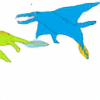HOME | DD
 ForbiddenParadise64 — Tardigradus: xenabomini
ForbiddenParadise64 — Tardigradus: xenabomini

Published: 2014-10-08 23:19:56 +0000 UTC; Views: 853; Favourites: 5; Downloads: 0
Redirect to original
Description
Clade: xenabomini:
Species: 600
These creatures are a more unusual form of quasignavid, having developed along a very different body plan. Instead of atrophying their middle limbs, most members have developed a hexapedal bodyplan with a single arm as a manipulator. This has proved quite successful in their main homeland of Australia, though they are also prevalent in some other locations, particularly South America, New Caledonia and even Antarctica. Their prevalence has surprisingly allowed them to take a number of niches, and means that their anatomy allows them to take a significantly more variable approach to ecological positions, being very different to other forms. In the past, they were a more diverse clade, especially in Antarctica before it froze over. The smallest species known is the soil-swimmer, a small Australian form which resembles a mole in ecological niche, using its many limbs to swim through soil very efficiently and quickly, reaching no more than 20cm in length. The largest living species is the trumpet-head, another Australian form which has a sound organ located below its lower jaw, resembling a reverse of the dinosaur parasaurolophus. Females measure 11m long, 3.2m at the shoulder and weigh up to 5 tonnes, while males are about 2/3s of the size. The largest extinct one though was an enormous creature known as Austrotitan, an Antarctic giant that briefly evolved in the decline of infinicollids in the region before the K-T extinction, measuring 17m long, around 5m tall and weighing approximately 17 tonnes-enough to give many infinicollids a run for their money.
Species include:
A. Soil-swimmer: a subterranean oddity, it has an exceptionally compact body and powerful legs, with very efficient digging. It’s arm is dart like and can grab prey from a long distance, similar to a frog’s tongue.
B. Silk-spinner: a South American species which lives in the Amazon region, spinning complex webs and catching various smaller creatures, particularly pteropsiods and gnaviforms. Measures about 60cm in length and weighs about 2kg.
C. Pseudo-unicorn: a desert dwelling herbivore that bears a superficial resemblance to the unicorn of India, having a bony horn on the top of its head, while using its forelimb to dig for bulbs in the harsh weather. Females measure about 3.5m long, 1.3m tall and weighs about 350kg, with males slightly smaller but with a longer horn.
D. Mutilator: a powerful mesopredator living in Indonesia, has a long powerful neck and weak jaws, using its head like a hatchet to deliver a killing blow while its arm grabs the prey to prevent struggling. Females measure up to 1.7m long and weigh 35kg, while males are 1.2m and weigh 15kg.
E. Sticker: the sticker is another Indonesian form which has a much more peaceful diet, burrowing its head into bark to get at the pseudarthropods inside. One of the least dimorphic, with both genders measuring about 1.4m long and weighing up to 20kg.
F. Blizzardbeast: a remarkable creature living in the cold of the Antarctic terrabrachid forests, this animal uses a combination of a thick fur coat and anti-freeze in its blood to survive. Measures about 1.7m tall, and weighs about 500kg.
G. Xenomorphs: a very dominant Australian predator, these are social predators, capable of dominating their environments using brute force and power, as well as being very fast and intelligent. Females measure more than 4m long, 1.7m tall and weigh about 350kg, while males are 3.5m long, 1.5m tall and weigh 200kg.
H. Trumpethead: the largest living member of their group, these animals are elephantine creatures that function as giant grazers, varying significantly in size as seen earlier. They use their hollowed extensions of their chins to create fascinating noises to communicate, similar to immense whistles.
I. Austrotitan: this extinct giant has not much known about it, other than that it was a browser similar to many infinicollids in lifestyle, though using its extendable mouth in place of a long neck or trunk.
Predators:
Being so variable in proportions and niche, predators come in many sizes. Since most come from Australia, they have each other to fear of course. They will often fall prey to larger spiderfaces or predatory ramfastomids like the jared-leto, though others probably don’t have predators as adults.

















